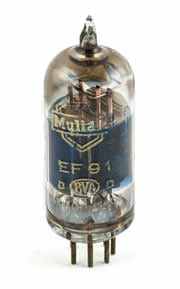Pentode Valve / Vacuum Tube
The pentode valve or pentode vacuum tube has a total of five active elements within the envelope, having a further grid called the screen grid beyond that used by a triode.
Vacuum Tube / Thermionic Valves Includes:
Basics
How does a tube work
Vacuum tube electrodes
Diode valve / tube
Triode
Tetrode
Beam Tetrode
Pentode
Equivalents
Pin connections
Numbering systems
Valve sockets / bases
Travelling wave tube
The pentode valve or pentode vacuum tube is widely used in many amplifier applications. It provides a high level of gain, overcoming the ‘kink’ in the response curve of the tetrode valve.
In overcoming this non-linearity, the pentode valve or pentode vacuum tube is able to provide high levels of performance needed in many circuits.

EF91 Pentode valve / vacuum tube
Pentode vacuum tube basics
The pentode vacuum tube or pentode valve consists of five electrodes - hence the name pentode. In order from the centre where the heater is located these electrodes are:
- Cathode: As with other forms of vacuum tube or valve, in the pentode the cathode is heater and emits electrons into the evacuated envelope.
- Control grid: As with other forms of vacuum tube, in the pentode the control grid is commonly maintained negative with respect to the cathode and it is used to control the flow of electrons between the cathode and anode.
- Screen grid: The screen grid is operated at a fixed positive potential, but below that of the anode and it provides screening between the anode and control grid, which considerably improved the performance. It is decoupled to ground using a capacitor to ensure that the screening is effective.
- Suppressor grid: In the pentode valve / vacuum tube, the suppressor grid is generally maintained at a low voltage, often connected directly to the cathode. Its function is to create a lower voltage region between the screen grid and the anode. It suppresses the secondary emission where high energy electrons hitting the anode at high speed have a tendency to bounce off. This effect causes a kink in the response curve of tetrode valves. In this way it enables the pentode to provide a high amplification factor along with the ability to operate at high frequencies.
- Anode: The anode or plate is operated at a high potential and it is the electrode to which electrons are ultimately drawn in the pentode or any other valve.
The electrodes in the pentode tube are physically arranged concentrically around the cathode.
Diagrammatically in the circuit symbol used in the electronic circuit designs, the various grids are show in order between the cathode and the anode.

Pentode tube circuit
The typical pentode tube circuit or pentode valve circuit follows very much the format for the triode and beam tetrode circuits. Although grounded grid and other configurations were used, the common cathode circuit was by far the most widely used.

As usual the cathode has a resistor between it and ground. Current flowing through the cathode means that a voltage is developed across the resistor R2 and as the grid is at ground potential as a result of R3, this means that the grid operates with the required negative potential. R2 is decoupled to ensure that no signal is developed across the resistor.
R4 is normally a high value, often around 100kΩ raises the potential of the screen grid. It is decoupled to ground via C4. This ensures it is able to effectively act as a screen between the anode and control grid circuits.
The suppressor grid is normally connected to the cathode. Sometimes the suppressor grid is connected internally – no external pin is available. Occasionally the suppressor grid is connected to ground rather than the cathode. This may happen if the cathode has a low resistance component such as a choke in the cathode circuit.
R1 serves as the anode resistor across which the amplified signal is developed.
More Electronic Components:
Batteries
Capacitors
Connectors
Diodes
FET
Inductors
Memory types
Phototransistor
Quartz crystals
Relays
Resistors
RF connectors
Switches
Surface mount technology
Thyristor
Transformers
Transistor
Unijunction
Valves / Tubes
Return to Components menu . . .



